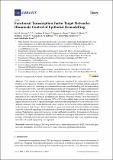Functional Transcription Factor Target Networks Illuminate Control of Epithelial Remodelling
Author(s)
Overton, Ian M.; Sims, Andrew H.; Owen, Jeremy A.; Heale, Bret S. E.; Ford, Matthew J.; Lubbock, Alexander L. R.; Pairo-Castineira, Erola; Essafi, Abdelkader; ... Show more Show less
Downloadcancers-12-02823.pdf (2.508Mb)
Publisher with Creative Commons License
Publisher with Creative Commons License
Creative Commons Attribution
Terms of use
Metadata
Show full item recordAbstract
Cell identity is governed by gene expression, regulated by transcription factor (TF) binding at cis-regulatory modules. Decoding the relationship between TF binding patterns and gene regulation is nontrivial, remaining a fundamental limitation in understanding cell decision-making. We developed the NetNC software to predict functionally active regulation of TF targets; demonstrated on nine datasets for the TFs Snail, Twist, and modENCODE Highly Occupied Target (HOT) regions. Snail and Twist are canonical drivers of epithelial to mesenchymal transition (EMT), a cell programme important in development, tumour progression and fibrosis. Predicted “neutral” (non-functional) TF binding always accounted for the majority (50% to 95%) of candidate target genes from statistically significant peaks and HOT regions had higher functional binding than most of the Snail and Twist datasets examined. Our results illuminated conserved gene networks that control epithelial plasticity in development and disease. We identified new gene functions and network modules including crosstalk with notch signalling and regulation of chromatin organisation, evidencing networks that reshape Waddington’s epigenetic landscape during epithelial remodelling. Expression of orthologous functional TF targets discriminated breast cancer molecular subtypes and predicted novel tumour biology, with implications for precision medicine. Predicted invasion role<i>s</i> were validated using a tractable cell model, supporting our approach.
Date issued
2020-09-30Department
Massachusetts Institute of Technology. Department of PhysicsPublisher
Multidisciplinary Digital Publishing Institute
Citation
Cancers 12 (10): 2823 (2020)
Version: Final published version